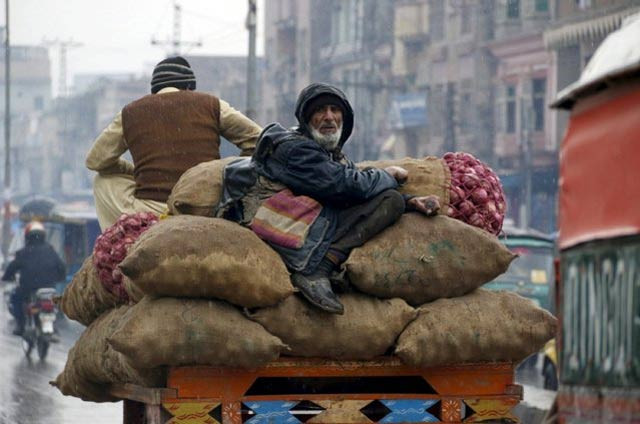Decline in exports indicates economic emergency in Pakistan
Exports as percentage of GDP fell from 14% in 2011 to 11% in 2015

Exports as percentage of GDP fell from 14% in 2011 to 11% in 2015. PHOTO: REUTERS
According to the world development indicators, exports as a percentage of GDP for Pakistan have fallen from 14% in 2011 to 11% in 2015.
Trade map: Why are Pakistan’s exports declining?
Although the global trade has decreased in 2015, the looming external debt position of Pakistan makes the impact of the decline ever more daunting. The total debt service as a percentage of exports of goods, services and primary income has risen from 11.3% in 2008 to 19.1% in 2014.
Over the previous decade, the inflow of remittances into Pakistan has taken an unprecedented importance in the balance of payments. Although remittances and capital inflows are important sources of foreign exchange, the policymakers need to address the falling trend in exports.
With increasing debt payments to the IMF and other creditors, Pakistan must ensure continuous inflow of foreign exchange in order to meet the obligations.
Exports are a crucial component of foreign exchange inflow. An investigation into the export pattern is necessary as policy measures to promote trade including currency valuations, tax reliefs and exemptions, free trade agreements are implemented.
Ministry that set up $35b export target says it is no longer possible
Analysing trade data from the UN Comtrade, approximately half of the exports from Pakistan are destined to the US, China, Germany, Spain, Italy, the UK and the UAE. They account for approximately 45% of global trade.
Even though economic conditions are relatively weak in these markets, they are the most important destinations for exporters around the world.
Exported products
On the other hand, the products exported by Pakistan are not the most popular in global trade. The top 10 six-digit HS codes exported from Pakistan in 2015 include textile products and cereals (semi-milled or whole-milled rice has been the top exported product from 2005 to 2015).
The top 10 products cumulatively account for approximately one-third of the exports from Pakistan but only 0.5% of the global trade flow. Therefore, exports from Pakistan are not only heavily concentrated in primary products and low value-added goods but are also limited to products that contribute negligibly to the global trade.
Further analysis suggests that exports are highly sensitive to fluctuations in global commodity prices, particularly of wheat, cotton and rice. There was an upward trend in the global prices of commodities from 2007 to 2011, consequently increasing the export value of several commodities, followed by a decrease in prices.
For instance, exports of raw cotton increased from $47 million in 2007 to $370 million in 2011 but decreased to $100 million in 2015. Similarly, exports of cotton yarn increased from $1.21 billion in 2008 to $2.23 billion in 2013 but decreased to $1.55 billion in 2015. Exports of semi-milled or whole-milled rice increased from $1.1 billion in 2007 to $2.3 billion in 2008 and decreased to $1.4 billion in 2015.
Although exports of primary products may bring a windfall during certain periods, they increase the exposure of the domestic agricultural sector to global price shocks.
Pakistan’s exports unlikely to reach 2018 target
Trade composition
Although most of the global trade is destined for the aforementioned markets, the composition of trade is likely to differ across destinations. Pakistan mainly exports intermediate goods to China and consumer goods to the US and European Union.
Pakistan exported $4.35 billion worth of intermediate goods in the textile industry such as yarn and fabric in 2015 but also exported $8.35 billion worth of consumer goods in textile that require yarn and fabric as inputs. This has increased the dependency of the value-added consumer goods on imported inputs.
Further, it has increased the vulnerability of local producers of raw cotton, cotton yarn and fabric to fluctuations in the global commodity prices.
Therefore, establishment of long-term production linkages between domestic and foreign entities in various industries is essential. It is imperative that exporters determine their potential in the global value chains and trade accordingly.
Considering that the most important trading partners are developed and advanced countries, they are more likely to churn out products through innovation. The exporters must adapt and realise the gains from the introduction of newer products and their varieties, even within traditional industries such as the textile industry. Free trade agreements should be negotiated to promote export of newer products that are likely to generate greater export revenue and provide easier access for those exporters that would otherwise fail to export.
The GSP Plus status awarded by the EU needs to be better utilised to help reverse the current trend of exports.
It is imperative that appropriate trade policies are adopted which support the conversion of primary products into processed products domestically through further investments in the food, textile and other industries.
Mango exports likely to increase to 120,000 tons
Further, the exporters must be able to adapt to the changes in tastes and preferences in their destination markets.
With the help of adequate production linkages across different industries and based on the needs of the destination markets, products with varying input mix need to be produced.
Similarly, integration into global production networks is necessary to generate export revenue rather than the reliance on irregular exchanges in the global market based on price fluctuations.
Although manufactured products themselves may face volatility in their output prices, the ability to produce different varieties may help reduce the adverse impact on the domestic economy from price fluctuations in the global commodity market.
The writer is an assistant professor of economics & research fellow at CBER, IBA
Published in The Express Tribune, July 25th, 2016.
Like Business on Facebook, follow @TribuneBiz on Twitter to stay informed and join in the conversation.



















COMMENTS
Comments are moderated and generally will be posted if they are on-topic and not abusive.
For more information, please see our Comments FAQ